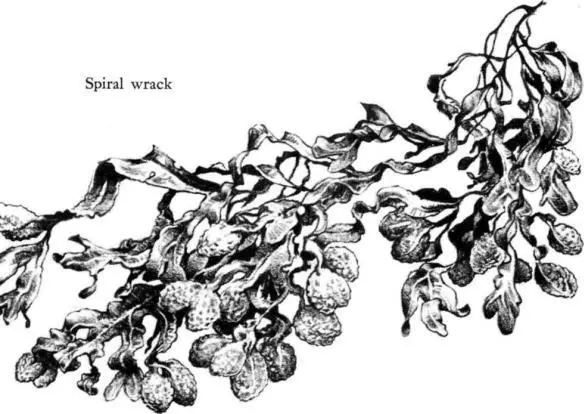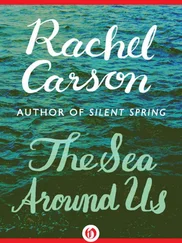Darkness brings the jungles of the land to life, but the night of the rockweed jungles is the time of the rising tide, when water pours in under the masses of weed, stirring out of their low-tide quiescence all the inhabitants of this forest.
As the water from the open sea floods the floor of the weed jungles, shadows flicker again above the ivory cones of the barnacles as the almost invisible nets reach out to gather what the tide has brought. The shells of clams and mussels again open slightly and little vortices of water are drawn down, funneling into the complex straining mechanisms within the shellfish all the little spheres of marine vegetables that are their food.
Nereid worms emerge from the mud and swim off to other hunting grounds; if they are to reach them they must elude the fishes that have come in with the tide, for on the flood tide the rockweed forests become one with the sea and with its hungry predators.

Shrimp flicker in and out through the open spaces of the forest; they seek small crustaceans, baby fish, or minute bristle worms, but in their turn are pursued by following fish. Starfish move up from the great meadows of sea moss lower on the shore, hunting the mussels that grow on the floor of the forest.
The crows and the gulls are driven out of the tidelands. The little gray, velvet-cloaked insects move up the shore or, finding a secure crevice, wrap themselves in a glistening blanket of air to wait for the falling of the tide.
The rockweeds that create this intertidal forest are descendants of some of the earth’s most ancient plants. Along with the great kelps lower on the shore, they belong to the group of brown seaweeds, in which the chlorophyll is masked by other pigments. The Greek name for the brown algae—the Phaeophyceae— means “the dusky or shadowy plants.” According to some theories, they arose in that early period when the earth was still enveloped in heavy clouds and illuminated only by feeble rays of sunlight. Even today the brown seaweeds are plants of dim and shadowed places—the deep submarine slopes where giant kelps form dusky jungles and the dark rock ledges from which the oarweeds send their long ribbons streaming into the tides. And the rockweeds that grow between the tide lines do so on northern coasts, visited often by cloud and fog. Their rare invasions of the sunny tropics are accomplished under a protective cover of deep water.
The brown algae may have been the first of the sea plants to colonize the shore. They learned to adjust themselves to alternating periods of submersion and exposure on ancient coastlines swept by strong tides; they came as close to a land existence as they could without actually leaving the tidal zone.
One of the modern rockweeds, the channeled wrack of European shores, lives at the extreme upper edge of the tidelands. In some places its only contact with the sea is an occasional drenching with spray. In sun and air its fronds become blackened and crisp so that one would think it had surely been killed, but with the return of the sea its normal color and texture are restored.
The channeled wrack does not grow on the American Atlantic coast, but there a related plant, the spiral wrack, comes almost as far out of the sea. It is a weed of low growth, whose short sturdy fronds end in turgid, rough-textured swellings. Its heaviest growth is above the high-water mark of the neap tides, so of all the rockweeds it lives closest inshore or nearest the water line of exposed ledges. Although it spends nearly three-fourths of its life out of water, it is a true seaweed and its splashes of orange-brown color on the upper shore are a symbol of the threshold of the sea.
These plants, however, are but the outlying fringe of the intertidal forest, which is an almost pure stand of two other rockweeds—the knotted wrack and the bladder wrack. Both are sensitive indicators of the force of the surf. The knotted wrack can live in profusion only on shores protected from heavy waves, and in such places is the dominant weed. Back from the headlands, on the shores of bays and tidal rivers where surf and tidal surge are subdued by remoteness from the open sea, the knotted wrack may grow taller than the tallest man, though its fronds are slender as straws. The long surge of the swell in sheltered water places no great strain on its elastic strands. Swellings or vesicles on the main stems or fronds contain oxygen and other gases secreted by the plant; these act as buoys when the weeds are covered by the tide. The bladder wrack has greater tensile strength and so can endure the sharp tugging and pulling of moderately heavy surf. Although it is much shorter than the knotted wrack it also needs the help of air bladders to rise in the water. In this species the bladders are paired, one of each pair on either side of the strong midrib; the bladders, however, may fail to develop where the plants are subjected to much pounding by surf, or when they grow at the lower levels of the tidal zone. At some seasons the ends of the branches of this wrack swell into bulbous, almost heart-shaped structures; from these the reproductive cells are liberated.

The sea wracks have no roots, but instead grip the rocks by means of a flattened, disc-like expansion of their tissues. It is almost as though the base of each weed melted a little, spreading over the rock and then congealing, thereby creating a union so firm that only the thundering seas of a very heavy storm, or the grinding of shore ice, can tear away the plants. The seaweeds do not have a land plant’s need of roots to extract minerals from the soil, for they are bathed almost continuously by the sea and so live within a solution of all the minerals they need for life. Nor do they need the rigid supporting stem or trunk by which a land plant reaches upward into sunlight—they have only to yield themselves to the water. And so their structure is simple—merely a branching frond arising from the holdfast, with no division into roots and stems and leaves.
Looking at the prostrate, low-tide forests of the rockweeds that cover the shore with a many-layered blanket, one would suppose that the plants must spring from every available inch of rock surface. But actually the forest, when it rises and comes to life with the flooding tide, is fairly open and sprinkled with clearings. On my own shore in Maine, where the tides rise and fall over a wide expanse of intertidal rock, and the knotted wrack spreads its dark blanket between the high and low waters of the neap tides, the areas of open rock around the holdfast of each plant are sometimes as much as a foot in diameter. From the middle of such a clearing the plant rises, its fronds dividing repeatedly, until the upper branchings extend out over an area several feet across.
Far below, at the base of the fronds that swing with the undulation of the passing waves, the rocks are stained with vivid hues, painted in crimson and emerald by the activities of sea plants so minute that even in their thousands they seem but part of the rock, a surface revelation of jewel tones within. The green patches are growths of one of the green algae. The individual plants are so small that only a strong lens could reveal their identity—lost, as individual blades of grass are lost in the lush expanse of a meadow, in the spreading verdant stain created by the mass. Amid the green are other patches of a rich and intensely glowing red, and again the growth is not separable from the mineral floor. It is a creation of one of the red seaweeds, a form that secretes lime in thin and closely adhering crusts over the rocks.
Читать дальше














